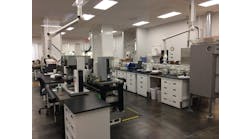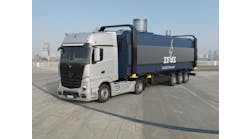Portability is ubiquitous in the consumer electronics world. Extending this interoperability to industrial automation holds disruptive potential.
As Domenico Napoli, future offers leader for process automation at Schneider Electric, told Control Global Editor-in-Chief Len Vermillion, on the Control Amplified podcast:
“When we talk about segregating software from hardware, think of the world that we have today with laptops and cell phones, where you have a lot of different hardware vendors and manufacturers using the same underlying software. That's what we want in the industrial automation space, making sure everyone can use the same software, but run that software on their specific hardware or any vendor's hardware.”
One of the keys to attaining this level of plug-and-play accessibility is open automation, a key theme at the ARC Advisory Group Forum in Orlando the week of Feb. 4.
“When we talk about segregating software from hardware, think of the world that we have today with laptops and cell phones, where you have a lot of different hardware vendors and manufacturers using the same underlying software. That's what we want in the industrial automation space, making sure everyone can use the same software, but run that software on their specific hardware or any vendor's hardware.” -- Domenico Napoli, future offers leader for process automation at Schneider Electric, on Control Global's Control Amplified podcast.
Several major technology providers, including Schneider Electric and Rockwell Automation, made announcements related to open automation. Schneider Electric announced the release of a distributed control node software framework developed in collaboration with Intel and software company Red Hat. The framework is aligned with Open Process Automation (OPA) Forum goals for interoperability and portability.
“The DCN framework is key to fostering an open automation approach, enabling industrial businesses to grow and innovate for the future. Its interoperability and portability help our customers enjoy the freedom of shaping technology around their business needs – and not the other way around," said Nathalie Marcotte, senior vice president of process automation at Schneider Electric, in a news release.
Rockwell Automation also announced upgrades to its PlantPAx distributed control system using OPA's O-PAS standard.
During the forum, I sat down with OPA members Trevor Cusworth, vice president of sales and marketing, Collaborative Systems Integration (CIS) and Ryan Smeltzer, automation program manager, Exxon Mobil Technology and Engineering Company, to discuss their involvement with OPA and how development and implementation of the standard is progressing. Here’s an edited version of that conversation.
CP: Can you discuss the field trial at your Baton Rouge facility?
Ryan Smeltzer: It's an early commercial deployment of an open standards-based control system. It’s been underway for around two years now at one of our chemicals facilities in Baton Rouge, Louisiana. And we're just coming to the point this year where we're going to perform a factory acceptance test. This is where we’ve built the system, installed the software and the control applications on it and have it hooked up to a simulator. It’s still offline; it's not at the plant. In another six weeks (March 2024), we're going to perform the integrated test of that system prior to moving it to the plant and commissioning it. This will be the control system that operations uses to run the plant. It's not running in parallel (to an older system); it's a rip-and-replace with an OPA-based system. That will be the first at that scale of an OPA architecture.
"One of the things I think that’s maybe taken for granted is that most of the automation solutions out there today have been built with some degree of standards. The challenge is there's too many standards. What we've done with the Open Process Automation Forum is we’ve tried to pick a few standards and make sure they play together." -- Ryan Smeltzer, automation program manager, Exxon Mobil Technology and Engineering Company
Obviously, we've done some other work and some other operating companies have done other work, but it's been on a smaller scale, and a lot of times it's been offline as more of a testbed development system. It has to last beyond one or two years, so you have to figure out the support model, not just whether the technology works or meets operations' needs, but how do we sustain it over the lifecycle of the asset? It's pretty exciting, and we're going in a brownfield application, which is pretty complex. What I mean by that is, operations is accustomed to a certain set of functionality, so you must meet or beat that just to get your foot in the door. While we're doing that, we’re also looking at other opportunities to apply OPA-based or open-architecture-based solutions in Exxon Mobil.
CP: Trevor, tell me a little bit about CSI and your efforts around open automation.
Trevor Cusworth: I just joined CSI. It’s a startup, with me, two ex-Exxon people and a fourth person. And our vision is to commercialize OPA. We saw a need for companies now to start expanding into this arena. I came from a large vendor of control systems, Schneider Electric, where I worked for about 15 years, but I've also been heavily involved in the open process automation forum since it started in 2016. I was the co-chair for six years, and I've seen this progress to a point now where we actually have a standard that we can build to. You will hear a lot of talk here at the Forum about open standards, open technology. It seems to be the direction of where everything's going. Not open source but open interfaces, so you don't get locked into one vendor. You can actually pick and choose the components you want to use, and they're guaranteed to work together as long as they've been certified.
Ryan Smeltzer: I think that’s the secret sauce. One of the things I think that’s maybe taken for granted is that most of the automation solutions out there today have been built with some degree of standards. The challenge is there's too many standards. What we've done with the Open Process Automation Forum is we’ve tried to pick a few standards and make sure they play together. And if there was any kind of white space or a gray space in between those standards, we close that. And so we have the ability to deliver solutions to achieve some of what we call the quality attributes – interchangeability of hardware, interoperability of components – so if I buy a controller from company A and a controller from company B, I can plug those into a system with a common backbone, and they can talk to each other, and they share an information model. That’s not new news, but I think it gets taken for granted that what we're really trying to do is reduce the number of standards and make sure the ones we pick are working together.
CP: If you could summarize the progress you have made with OPA, what would you say? What does the future hold for open automation?
Trevor Cusworth: At the beginning, we wrote a business guide, which was like the case for change, and it talked about what industries we would cover. It talked about the benefits to both the end user and to the vendors. There are two groups. There's a business working group that focuses on the business side of OPA, and then there's the technical working group that's working on the standards. They've released version 2.1 of the standard last year, and they're working on version three right now. But 2.1 was the first one that vendors could start building products against. It has sufficient clarity, so you could actually start building products that met that standard.
Currently, I'm working on an adoption guide. That's going to be for all the people in the ecosystem, from end users to system integrators to service providers. It’s all about saying, “Alright, OPA is coming, what do I need to do to prepare? How do I get my people trained? How do I get them certified and qualified? How do I market myself for this new technology?” We released the first version of the adoption guide last year, which was aimed at end users, and now this year we're going to be publishing one with system integrators in mind.
The ecosystem will change as we move to OPA. In the past, typically, an end user would engage an engineering contractor, and then they would work with a vendor. Now that you can choose many different vendors, the system integrator is going to become very important in this picture because they're the ones that are going to integrate all these different components together. So we're really creating new roles with different types of responsibility. The system integrator is going to be responsible for the performance of the system, and they're going to be the ones that have to troubleshoot and work out what issues are happening and work with the vendors to fix those problems. It's a big change. It's not just technology. It's about roles and responsibilities and how everyone's going to interact in the future.
CP: How is that going to help enable this digital transformation?
Trevor Cusworth: Well, Ryan talked about how traditional systems were closed and proprietary, so you couldn't insert new technology, especially IT technology into those systems. You have to bolt it on the outside. With open, you can now decide where you want to run that technology. Plus, the components are much more powerful now than the traditional control systems. So we've got these small IPCs industrial computers, that run at like 30,000 instructions per second versus a thousand instructions per second of a traditional DCS controller. You’ve got so much more power now that you can start to do new things like AI. It’s a convergence of operational technology and information technology.
CP: Is there a cybersecurity component to all of this?
Trevor Cusworth: In the past, with these older systems, you bolted cybersecurity on from the outside. Part of the standard is to design cybersecurity to be built into those components, so it's built-in from the ground up. It's not an afterthought, so it's a huge focus. There’s actually a whole group within the Forum that focuses on cybersecurity to all the latest standards.



